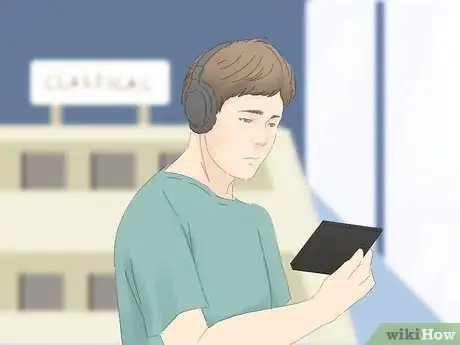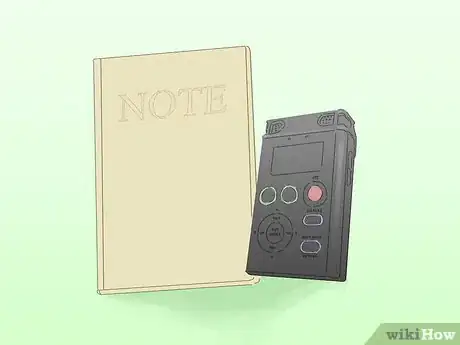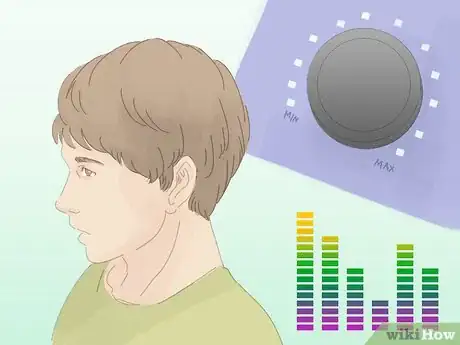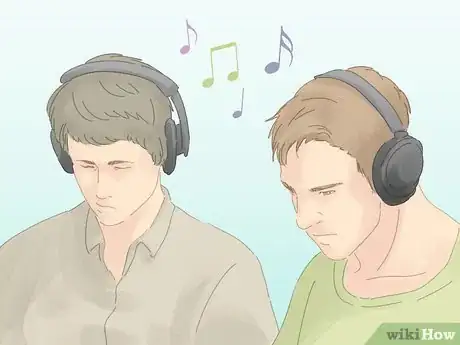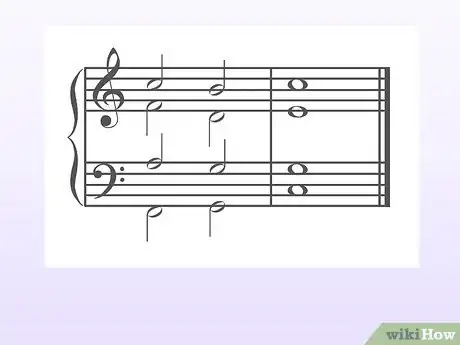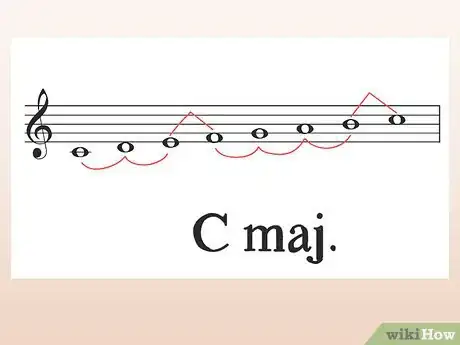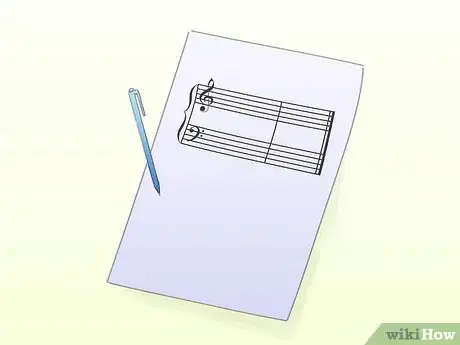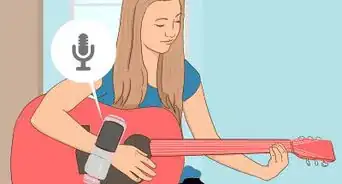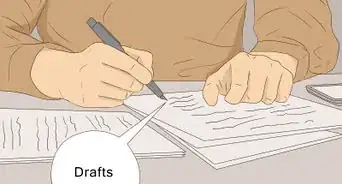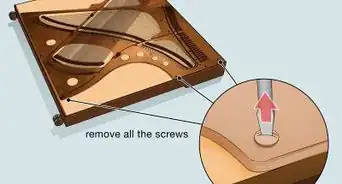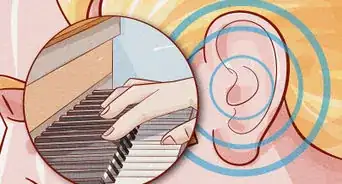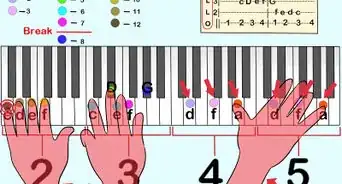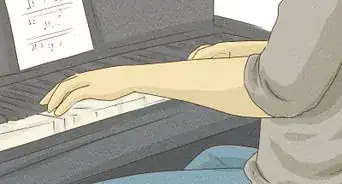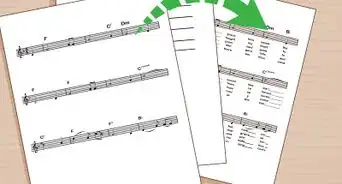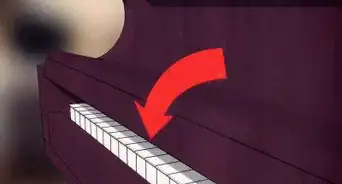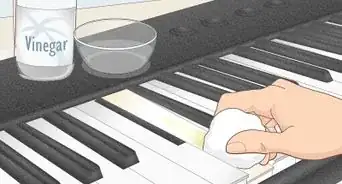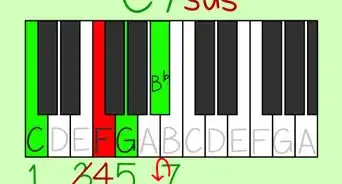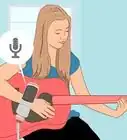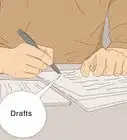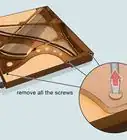This article was co-authored by wikiHow Staff. Our trained team of editors and researchers validate articles for accuracy and comprehensiveness. wikiHow's Content Management Team carefully monitors the work from our editorial staff to ensure that each article is backed by trusted research and meets our high quality standards.
There are 7 references cited in this article, which can be found at the bottom of the page.
wikiHow marks an article as reader-approved once it receives enough positive feedback. In this case, 82% of readers who voted found the article helpful, earning it our reader-approved status.
This article has been viewed 163,498 times.
Learn more...
Alongside the guitar, the piano is arguably the best instrument to write music for. Although it's difficult to learn at first, a piano allows you to play multiple voices at once, one for each finger. The piano has been a go-to instrument for many of the world's greatest composers since it was invented. Writing music is a difficult, time-consuming process however, and the piano doesn't make it any easier unless you're already an advanced player. Even if you've had success writing with other instruments in the past, composing for a piano offers its own set of procedures.
Steps
Getting Inspired to Write Piano Music
-
1Listen to piano music.[1] There is a vast amount of incredible music written specifically for the piano. Even if the composition you're writing isn't ultimately meant to be heard on the piano, hearing other finished compositions when you're trying to get inspired can be just the thing you need.
- Classical and jazz are the two most noteworthy styles of piano playing. Even if you're only going to be playing in one or the other (or a more contemporary style like pop) it's a good idea to give a listen to these different styles. Keep an ear out for the different chords the players use depending on the style.
- Look into the work of Liszt, Chopin or Satie for great classically-based piano works.
- For jazz, Bill Evans, Dave Brubeck and Chick Corea are all players worth looking into.
-
2Practice scales on the piano. Whether you're starting out or an advanced player, warming up your fingers with scales can encourage creativity to flow more freely once you get into the thick of composing. If you know a few scales, try warming up with one you're not as familiar with. Hearing the distinctive tone of a scale might spark the first ideas of a fresh composition.
- Scales are a very handy thing to know when it comes time to write melodies. While there's no sure method to write a great melody, knowing which scale you should be using will give you an idea of which notes to use and which to avoid.
Advertisement -
3Carry a notebook and handheld recorder wherever you go.[2] You never know when you're going to hit a creative stride. Unfortunately, a lot of the time, this happens to fall on the least convenient times where you're either far from an instrument or about to fall asleep. This is why it's a good idea to bring a notebook and/or sound recorder with you wherever you go. If you think of a great melody or rhythm, you can hum it into your mic and adapt it once you're by your piano again.
- Most cellphones have a recorder option. If you don't have a cellphone for this purpose, basic handheld recorders tend to be very affordable.
-
4Give yourself a break. Creativity cannot be forced. If you're trying to break through the writer's block and nothing's working, it may be time to give yourself a break from things. Go do something that has nothing to do with the creative process. Clean your house. Talk to a friend on the phone. Pet a cat. Better yet, take a nap. When you return to it, you don't want to feel any of the frustration you were grappling with before. Creativity is best when you're feeling relaxed.
- Going for a walk is a fantastic idea if you're getting frustrated. Many artists have some of their best creative epiphanies when they're out for a stroll.
-
5Think about what you might like to write music about.[3] Most music (even instrumental music) is directly inspired by something or someone. In some cases, the composer is driven by love and longing. Other times, he's trying to vent out bad emotions. Take a look at your life and single out some of the things that have most affected you in the past while. Have you gone through a break-up? Did you recently go on an unforgettable vacation? Anything that sparks feeling in you is fair game for musical inspiration.
Following an Informal Creative Process
-
1Try to listen out for music playing in your head. Many composers report hearing music in their head when they sit down to compose, as if the piece they're working on is already complete and just needs to be written down for the sake of others. Creative intuition isn't the sort of thing that can be forced, and a lot of it will depend on the way you're feeling at the time. However, if you can pick up an interesting musical idea in your head, don't hesitate to run with it.
- It's easy for our inner judge to get the best of us and censor ideas before we even try them out. When you're composing music, it's best if you drop this self-doubt. Even if you think something is a bad idea, there's a chance it may lead to something more promising when you start playing around with it.
-
2Think of mental imagery while you play. The experience of watching films has had a major impact on the way we associate music with visuals. In your mind's eye, try to picture a scene that would spark the same sort of emotions you'd hope to evoke in this composition. For instance, if you want a gentle, soothing composition, you might envision a quiet lake in springtime. Likewise, if you want something angry and dramatic, you might think of a warzone. From there, imagine what kind of music might score a visual shot like this.
- This technique doesn't always work, but if you're a visual thinker, it's certainly worth trying out.
-
3Compose a springboard idea.[4] Most compositions will start with a springboard idea, that is, the first part of the music written that all other pieces are based upon. This may be the most time-consuming part of your composition. It's all about latching onto the first part of your composition and running with it once you get it. Playing scales and experimenting with different chord shapes can turn this process into a sort of enjoyable play.
-
4Write follow-up ideas. If you play around on the piano and come up with a great idea, you should play that motif in your head and imagine what might come before or afterwards. Follow-up ideas should generally have the same tone and direction of your original idea. For the first while, focus on making ideas that work together. If you want a composition with surprising twists, you should only figure out that part of it once you have a firm structure in place.
-
5Play around with volume and dynamic.[5] Once you have some solid ideas, it's time to play around with them. One of the great things a piano has going for it is its sensitivity to volume and dynamics. Making some parts louder and others quieter is a tool that beginning composers often tend to overlook. Dynamics can make a world of difference to the emotional effect of a piece of music.
- Dynamics is defined as a show of change or difference within something. In the case of a musical performance, it refers to a player's treatment of volume. Some pianists play naturally louder than others, but a truly gifted performer will use quiets and lows to his advantage.
-
6Work some healthy repetition into your composition.[6] At some point, it's necessary to put a structure to your ideas. As you piece your song together, some ideas will be more deserving of building the song around them. A typical composition will have at least one or two recurring motifs therein. While repetition is used to emphasize an idea, repeating too much will rob the music of its interest. If your composition has a lot of repetition in it already, you should try to gradually modify the idea somehow. Adding or switching a single note can change your audience's response towards an idea.
- The idea of relying on repetition and slowly changing it over time is referred to as Minimalism.
-
7Add vocals if you want. A piano functions beautifully on its own, but like a guitar, it can help if you add vocals on top of it. Vocals are a great match for the texture of a piano. Vocal melodies can copy from the melodic right hand of your piano parts, or you can write a totally fresh part to add to the arrangement. Although vocals are tricky to pull off successfully while you're playing piano, it gives you opportunities to add harmonies that wouldn't have been possible with two hands on a piano.
- Lyrics are an obvious requirement in most cases if you want to add voice. Lyrics give you a chance to tell a more vivid story with your music. Of course, if you'd prefer it, you can sing without lyrics. Some compositions prefer to use the voice as another instrument, with "oooohs" and "aaahs" taking the place of lyrics.
-
8Get a friend's advice. Once your composition starts coming together, there's a moment of truth when you finally show it to someone else. Play a rough run-through of your composition for a friend whose taste you respect. Once you've finished playing it, ask your friend what he or she thinks could be improved upon it. It's important to see this as a step in the creative process rather than a time for judgement; whether they like it or not doesn't matter until you've put the final seal of approval on it. Take what they say into consideration, and contrast it with your own feelings towards the work.
-
9Make revisions.[7] A composition will start to come together more naturally once the first stages are through. Even if you like the version you've drafted, it's a good idea to run through the song and judge which parts of the composition could be improved, changed or removed altogether. Much like a good piece of writing requires editing before it's finished, a great composer will look at a piece carefully and do everything they can to refine it before calling it finished.
Composing Using Music Theory
-
1Decide upon a tonality. A composition's tonality states the key and whether it is Major or Minor.[8] At an early stage of composition, a key could be as simple as making an arbitrary choice, but it will have the biggest impact on the sound of your composition. If you finish your work later on and want to try it out in different keys, you should do so, but be forewarned that it takes a fair amount of work to transpose a composition note by note into another key.
-
1Explore chord progressions leading from the root chord.[9] The piano keyboard has been explored to death. Every possible combination has been tried and studied at this point. With that, theory can suggest the most appropriate chords. The most famous of these is the I-IV-V-vi progression (the lower case denotes a Minor chord). The Roman numerals indicate how many keys above the root the given chord is. These four chords have been proven to go together very well.
- Try using a chord map to get you started.[10]
- Although this might sound too mathematical at the start, the truth is that it'll come without thinking to you once you get the basics of theory down pat.
-
2Develop melodies from a chosen scale.[11] Scales are useful tools in the creation of melody. Although melodies need to be properly felt out in order to be memorable and effective, using a scale will narrow down the notes you're conventionally supposed to use.
- Make sure the scale you're using is in accordance with the chords and key you've chosen.
- The standard scale is a C Major scale. This scale is often used for vocal warm-ups before a performance.
-
3Experiment with tuning.[12] Some avant-garde composers in the 20th century would open up the piano itself and change the tuning of the strings, but prior to the adoption of equal temperament for keyboard instruments in the 18th century, there were numerous tunings in use. Changing all of the keys even a 16th of a step can result in a strange new experience of the piano. Be advised that messing around with a piano should only be done if you are an expert. Otherwise, you'll probably just end up sabotaging your piano for regular use.
-
4Record your work via notation. Notation is the technical language of music. If you're a serious composer, it's essential that you have at least some knowledge of notation and how to get your ideas down accurately on paper. Although it takes a little bit of time to get used to, there are fortunately lots of free online resources to help get you up to par with your notation reading and writing. If you're completely new to notation, you should try sight-reading a few basic songs on the piano until you're more used to it.
- There are digital notation programs that may prove easier to work with than pen and paper.
Community Q&A
-
QuestionWhere can I get musical experience?
 Community AnswerIf you're in school, join band, orchestra, or chorus. Otherwise, check with your local music shop, many have lessons onsite, and if they don't, they'll probably know where to direct you. From there, gaining experience is as simple as practicing your instrument.
Community AnswerIf you're in school, join band, orchestra, or chorus. Otherwise, check with your local music shop, many have lessons onsite, and if they don't, they'll probably know where to direct you. From there, gaining experience is as simple as practicing your instrument. -
QuestionHow do I write a classical song?
 Community AnswerListen to classical music for inspiration, study the trends in classical music, and eventually start to write your own pieces. I would pick one or two classical pianists that you admire to study in depth.
Community AnswerListen to classical music for inspiration, study the trends in classical music, and eventually start to write your own pieces. I would pick one or two classical pianists that you admire to study in depth. -
QuestionHow do I write my music or my composition?
 Community AnswerUse the most common chords and add lyrics. Use different variations of the chords and maybe even use broken chords (for pop).
Community AnswerUse the most common chords and add lyrics. Use different variations of the chords and maybe even use broken chords (for pop).
Warnings
- If you're using the piano as a medium for composing music for other instruments, especially the orchestra, try to know as much as possible about the other instruments before, because any compositions that were originally conceived on the piano may not necessarily work out for other instruments.⧼thumbs_response⧽
- Piano is a difficult instrument to learn. If you're not an advanced player, don't try to compose music that you wouldn't be able to perform yourself unless you know someone who will.⧼thumbs_response⧽
References
- ↑ http://www.soundonsound.com/sos/jan99/articles/20tips.458.htm
- ↑ http://www.soundonsound.com/sos/jan99/articles/20tips.458.htm
- ↑ http://www.soundonsound.com/sos/jan99/articles/20tips.458.htm
- ↑ http://www.soundonsound.com/sos/jan99/articles/20tips.458.htm
- ↑ http://www.soundonsound.com/sos/jan99/articles/20tips.458.htm
- ↑ http://www.soundonsound.com/sos/jan99/articles/20tips.458.htm
- ↑ https://takelessons.com/blog/writing-hit-piano-music
- ↑ http://www.studybass.com/lessons/bass-scales/the-difference-between-major-and-minor/
- ↑ http://www.pianolessons.com/piano-lessons/how-to-write-a-song.php
About This Article
Although composing music on the piano is a challenging process, you can get started by thinking about something that has affected you deeply, like a breakup or traveling to another country. Once you find your inspiration, try warming up with a few scales to help you come up with an appropriate melody. For example, you might come up with an angry, dramatic melody if you're thinking about a breakup. Then, play the music out in your head, using mental imagery like memories of the other person, before putting your composition down on paper. To learn more, including how to add vocals to your piano composition, read on!
